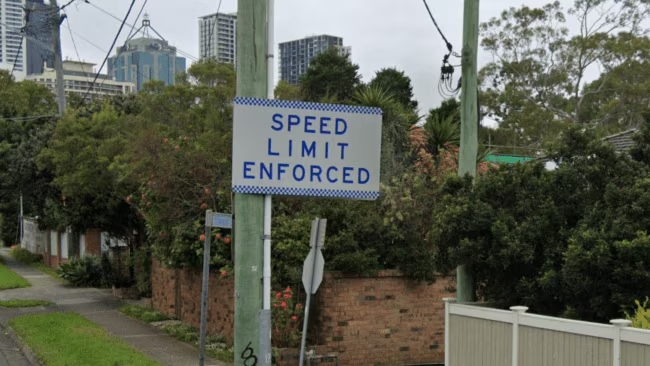
You've probably driven past hundreds of them without giving it much thought—those black and white signs that simply state 'speed limit enforced.' A Sydney driver recently sparked a lively online debate when they questioned whether this particular sign on Fullers Road in Chatswood was the most pointless piece of street furniture in the city.
Fair dinkum, it does seem a bit redundant, doesn't it? After all, aren't all speed limits enforced by law? But before we dismiss this sign as bureaucratic nonsense, there's more to the story than meets the eye.
The sign that started it all
The social media post that kicked off this discussion featured a simple 'speed limit enforced' sign, with the original poster asking if it was 'the most redundant street sign in Sydney.' The comments section quickly filled with fellow drivers venting about other seemingly pointless signage they'd encountered around the city.
One commenter complained about an equally baffling lane split around 'the smallest bend down the road,' while another pointed to those ubiquitous 'Speed cameras used in NSW' signs as being just as redundant.
A third chimed in about the frustrating 'NO LEFT TURN' signs with tiny exception plates underneath for vehicles under six metres—why not just write it for the majority of road users, they wondered?
What Transport NSW really thinks
But here's where it gets interesting. According to Transport for NSW, these seemingly obvious signs aren't as useless as they appear. A spokesperson explained to the original publication that speeding remains a significant problem on Australian roads, and these signs serve as crucial reminders.
'The message on this sign might be obvious, but with many NSW motorists still speeding, speed signs, enforcement and educational campaigns are some ways to remind motorists to drive within the speed limit'
The numbers back up this reasoning. In NSW, speeding consistently contributes to about 41 per cent of road fatalities and 24 per cent of serious injuries each year, which translates to almost 150 lives lost and 1,270 people seriously injured annually in that state alone.
The psychology of 'obvious' signage
What many drivers don't realise is that road signs aren't just legal notices—they're psychological tools. Even advisory signs that aren't technically enforceable limits send a powerful message, signalling drivers to reduce speed, stay alert and be prepared to stop.
The 'speed limit enforced' sign works on a principle called cognitive priming. When drivers see explicit reminders about enforcement, it triggers a mental check: 'Am I following the speed limit?' This momentary self-assessment can be enough to encourage compliance, even among those who might otherwise push the boundaries.
Understanding Australian road signs
Regulatory signs are white with black text in a red circle—it's illegal to disobey these.
Advisory signs are yellow with black text and provide advice on appropriate speeds in an area.
Speed limit enforcement signs fall into a third category: information signs that remind drivers of existing regulations.
Other 'pointless' signs that actually make sense
The social media thread highlighted several other signs that seem redundant but serve specific purposes. Those 'Speed cameras used in NSW' signs that drivers love to mock? They're actually part of a standardised system of guide and information signs that provide additional traffic information to guide driving.
The frustrating 'NO LEFT TURN—vehicles under 6m excepted' signs also have their place. Speed restriction and traffic control signs must be authorised by state and territory transport departments, and their design and installation follow strict guidelines—unauthorised signage can't be enforced, even if it looks official.
Even those lane closure signs around 'the smallest bend' serve a purpose. The objective of traffic management signage is to provide credible guidance that meets driver expectations while achieving a balance between road safety, land use, amenity and transport efficiency.
The sobering numbers
Recent statistics show just how critical road safety messaging really is. In the 12 months to August 2025, there were 1,352 road deaths in Australia, with males accounting for 1,005 of these fatalities compared to 347 females.
For the third year running, speeding has been ranked as the leading cause of car accidents by nearly two-thirds of Australian survey respondents.
Even more concerning, police crash reports indicate that speeding contributes to approximately 1 in 3 fatal crashes, though this is likely a conservative figure.
Current road safety reality check
- 624 drivers died in crashes during the 12-month period ending August 2025, representing a 9.5 per cent increase
- 30.6 per cent of road deaths involved people aged 40-64
- The risk of a fatal accident doubles with each 5 km/h increase above 60 km/h
- Research shows reducing speeds by just 11 per cent would reduce road deaths by 40 per cent
What this means for older drivers
For drivers over 60, these statistics take on particular relevance. Drivers aged 65-74 experienced a 19 per cent increase in deadly road accidents in 2023, with 138 deaths compared to 116 in 2022.
While we're generally experienced drivers who've been navigating roads for decades, we're also more vulnerable to serious injuries in crashes.
Recent research indicates persistent risks for older drivers in road safety projections, making those seemingly redundant reminder signs potentially more important than they first appear. That 'speed limit enforced' sign in Chatswood might seem patronising, but if it makes even one driver check their speedometer, it's doing its job.
Did you know?
Did you know?
Australia adopted a variation of the American traffic control device standards in 1960, then underwent major changes in 1974 when we transitioned to symbols instead of words and adopted the metric system for all road signage. This standardisation helps ensure consistent messaging across the country.
The evolution of Australian road signs
Our road signage hasn't always looked the way it does today. Australia closely follows United States practices for sign design, using yellow diamonds for warnings and green for directions, but some signs like speed limits and roadworks are influenced by United Kingdom usage.
Speed limits in Australia now range from 5 km/h in shared zones to 130 km/h on certain Northern Territory highways, with all signage standardised in kilometres per hour since metrication in 1974.
A sign of the times
So the next time you spot one of those 'obvious' road signs, remember there's usually more thought behind it than first meets the eye. That 'speed limit enforced' sign on Fullers Road might not win any awards for creativity, but in a country where we lose more than 1,000 people each year to road crashes, every reminder counts.
From bustling urban marterials to quiet outback highways, speed limit signs in Australia are more than just metal on a post—they're silent sentinels of safety, order and efficiency.
Have you encountered road signs that left you scratching your head? Or perhaps you've spotted some particularly clever signage that made you slow down and take notice? We'd love to hear about your experiences with Australia's sometimes bewildering, always fascinating world of road signage.
Original Article
https://www.kidspot.com.au/lifestyl...n/news-story/ff2f7069f250a84baed462b3d5f99ace
Speed limits in Australia—Wikipedia
Cited text: It is intended therefore to invoke particular caution.
Excerpt: The Reddit post that kicked off this discussion featured a simple 'speed limit enforced' sign
https://en.wikipedia.org/wiki/Speed_limits_in_Australia
Speed limits in Australia—Wikipedia
Cited text: This sign is used as a direct replacement for the slash-through speed derestriction signs common in Europe and elsewhere.
Excerpt: According to Transport for NSW, these seemingly obvious signs aren't as useless as they appear
https://en.wikipedia.org/wiki/Speed_limits_in_Australia
Speed limits in Australia—Wikipedia
Cited text: Speed limits are enforced in all areas of the country.
Excerpt: In NSW, speeding consistently contributes to about 41 per cent of road fatalities and 24 per cent of serious injuries each year
https://en.wikipedia.org/wiki/Speed_limits_in_Australia
The Ultimate Guide to Speed Limit Signs in Australia—New Signs
Cited text: These are advisory signs, not enforceable limits, but they send a powerful message.
Excerpt: Even advisory signs that aren't technically enforceable limits send a powerful message, signalling drivers to reduce speed, stay alert and be prepared to stop
https://newsigns.com.au/blogs/news/...imate-guide-to-speed-limit-signs-in-australia
The Ultimate Guide to Speed Limit Signs in Australia—New Signs
Cited text: While not classified as an official Speed Limit Sign, they signal the driver to reduce speed, stay alert and be prepared to stop.
Excerpt: Even advisory signs that aren't technically enforceable limits send a powerful message, signalling drivers to reduce speed, stay alert and be prepared to stop
https://newsigns.com.au/blogs/news/...imate-guide-to-speed-limit-signs-in-australia
Australian Speed Signs, Limits And Speed Zones | RACV
Cited text: A regulatory sign is a white sign that has black text in a red circle. It’s illegal to disobey these signs. An advisory sign is a yellow sign with bla...
Excerpt: Regulatory signs are white with black text in a red circle—it's illegal to disobey these.
https://www.racv.com.au/cars-transport/road-safety/road-rules/speed-limits-zones.html
Road signs in Australia—Wikipedia
Cited text: (G6-254) Speed Cameras Check Your Speed Now (used in New South Wales) (G6-327-1) Speed Camera (24 Hours) (Speed Limit) (used in New South Wales) (G6-3...
Excerpt: They're actually part of a standardised system of guide and information signs that provide additional traffic information to guide driving
https://en.wikipedia.org/wiki/Road_signs_in_Australia
The Ultimate Guide to Speed Limit Signs in Australia—New Signs
Cited text: Not every Speed Restriction Sign can be slapped up by your local council. In Australia, these are officially recognised as prescribed traffic control ...
Excerpt: Speed restriction and traffic control signs must be authorised by state and territory transport departments, and their design and installation follow strict guidelines—unauthorised signage can't be enforced, even if it looks official
https://newsigns.com.au/blogs/news/...imate-guide-to-speed-limit-signs-in-australia
The Ultimate Guide to Speed Limit Signs in Australia—New Signs
Cited text: In all cases, Speed Limit Signage must be authorised—unauthorised signage can’t be enforced, even if it looks official.
Excerpt: Speed restriction and traffic control signs must be authorised by state and territory transport departments, and their design and installation follow strict guidelines—unauthorised signage can't be enforced, even if it looks official
https://newsigns.com.au/blogs/news/...imate-guide-to-speed-limit-signs-in-australia
Speed Zones | Main Roads Western Australia
Cited text: The objective of speed zoning is to provide credible speed limits which meet driver expectations while achieving a balance between road safety, land u...
Excerpt: The objective of traffic management signage is to provide credible guidance that meets driver expectations while achieving a balance between road safety, land use, amenity and transport efficiency
https://www.mainroads.wa.gov.au/tec...c-engineering/traffic-management/speed-zones/
Monthly road deaths | National Road Safety Data Hub
Cited text: In the 12 months to August 2025, 1,005 males died in crashes, compared to 347 females. The road death count for males increased from 1,001 to 1,005 in...
Excerpt: In the 12 months to August 2025, there were 1,352 road deaths in Australia, with males accounting for 1,005 of these fatalities compared to 347 females
https://datahub.roadsafety.gov.au/progress-reporting/monthly-road-deaths
Car Accidents Survey and Statistics 2024—Budget Direct
Cited text: For the third year in a row, speeding was ranked the leading cause of car accidents by nearly two-thirds of Australian respondents.
Excerpt: For the third year running, speeding has been ranked as the leading cause of car accidents by nearly two-thirds of Australian survey respondents
https://www.budgetdirect.com.au/car-insurance/research/car-accident-statistics.html
Understanding Road Safety Statistics—Road Sense Australia
Cited text: Police crash reports indicate that speeding contributes to approximately 1 in 3 fatal crashes, likely a conservative figure 11.
Excerpt: police crash reports indicate that speeding contributes to approximately 1 in 3 fatal crashes, though this is likely a conservative figure
https://roadsense.org.au/understanding-road-statistics-aus/
Monthly road deaths | National Road Safety Data Hub
Cited text: By this measure, deaths were most frequently drivers, with 624 in the 12-month period ending August 2025 (a 9.5 per cent increase compared to the previous 12 ...
Excerpt: 624 drivers died in crashes during the 12-month period ending August 2025, representing a 9.5 per cent increase
https://datahub.roadsafety.gov.au/progress-reporting/monthly-road-deaths
Monthly road deaths | National Road Safety Data Hub
Cited text: In the 12-month period ending August 2025, 30.6 per cent of road deaths were aged 40 to 64 years (414 deaths).
Excerpt: 30.6 per cent of road deaths involved people aged 40-64
https://datahub.roadsafety.gov.au/progress-reporting/monthly-road-deaths
Car Accidents Survey and Statistics 2024—Budget Direct
Cited text: · According to the Victorian Government’s Transport Accident Commission (TAC), the risk of a fatality doubles with each 5 km/h increase above 60 km/h....
Excerpt: The risk of a fatal accident doubles with each 5 km/h increase above 60 km/h
https://www.budgetdirect.com.au/car-insurance/research/car-accident-statistics.html
Understanding Road Accidents Statistics in Australia [2024]—SA1NT
Cited text: According to the Monash University Accident Research Centre, reducing speeds by 11 per cent would reduce road deaths by 40 per cent.
Excerpt: Research shows reducing speeds by just 11 per cent would reduce road deaths by 40 per cent
https://www.saint.cc/blogs/journal/road-accidents-statistics-australia
Supporting road safety in 2024, after the deadliest year on Australia’s roads in 5 years | Insights | Convenience Advertising
Cited text: In just 12 months, drivers aged 65-74 have experienced a 19 per cent increase in deadly road accidents (138 in 2023 v 116 in 2022, an increase of 22 deaths).
Excerpt: Drivers aged 65-74 experienced a 19 per cent increase in deadly road accidents in 2023, with 138 deaths compared to 116 in 2022
https://convenienceadvertising.com.au/insights/road-safety-2024
Time-series projecting road traffic fatalities in Australia: Insights for targeted safety interventions—ScienceDirect
Cited text: Gender-specific forecasts indicate a sharper decline in male fatalities compared to females, while projections highlight persistent risks for older dr...
Excerpt: Recent research indicates persistent risks for older drivers in road safety projections
https://www.sciencedirect.com/science/article/pii/S0020138325000269
Road signs in Australia—Wikipedia
Cited text: In 1960, Australia adopted a variation of the American Manual on Uniform Traffic Control Devices (MUTCD) road sign design, which is a modified version...
Excerpt: Australia adopted a variation of the American traffic control device standards in 1960, then underwent major changes in 1974 when we transitioned to symbols instead of words and adopted the metric system for all road signage
https://en.wikipedia.org/wiki/Road_signs_in_Australia
Road signs in Australia—Wikipedia
Cited text: A major change expressed Australia's preference for a transition to adoption of symbols on signs in lieu of words, inspired by the Vienna Convention o...
Excerpt: Australia adopted a variation of the American traffic control device standards in 1960, then underwent major changes in 1974 when we transitioned to symbols instead of words and adopted the metric system for all road signage
https://en.wikipedia.org/wiki/Road_signs_in_Australia
Road signs in Australia—Wikipedia
Cited text: Australia closely follows the United States when it comes to road sign designing practices (for example, using yellow diamonds for warning signs, gree...
Excerpt: Australia closely follows United States practices for sign design, using yellow diamonds for warnings and green for directions, but some signs like speed limits and roadworks are influenced by United Kingdom usage
https://en.wikipedia.org/wiki/Road_signs_in_Australia
Speed limits in Australia—Wikipedia
Cited text: Speed limits in Australia range from 5 km/h (3.1 mph) shared zones to 130 km/h (81 mph). Speed limit signage is in km/h since metrication on 1 July 19...
Excerpt: Speed limits in Australia now range from 5 km/h in shared zones to 130 km/h on certain Northern Territory highways, with all signage standardised in kilometres per hour since metrication in 1974
https://en.wikipedia.org/wiki/Speed_limits_in_Australia
The Ultimate Guide to Speed Limit Signs in Australia—New Signs
Cited text: From bustling urban arterials to quiet outback highways, speed limit signs in Australia are more than just metal on a post—they’re silent sentinels of...
Excerpt: From bustling urban arterials to quiet outback highways, speed limit signs in Australia are more than just metal on a post—they're silent sentinels of safety, order and efficiency
https://newsigns.com.au/blogs/news/...imate-guide-to-speed-limit-signs-in-australia







